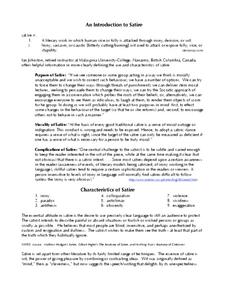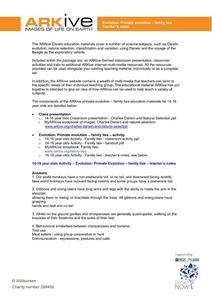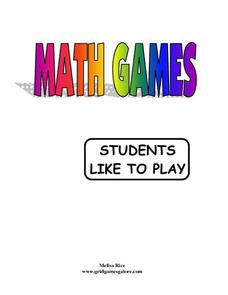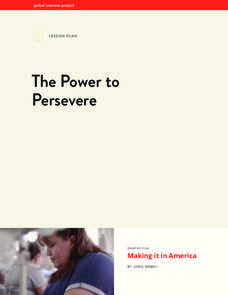K12 Reader
Have You Got the Time?
Time and time measurement is the subject of a comprehension learning exercise that asks kids to read a short passage about time, and then respond to a series of questions based on the article.
EngageNY
Overcoming a Third Obstacle to Factoring— What If There Are No Real Number Solutions?
Time for pupils to use their imagination! Learners examine the relationship between a system with no real solution and its graph. They then verify their discoveries with algebra.
Houghton Mifflin Harcourt
Off to Adventure!: English Language Development Lessons (Theme 1)
Give language skills a boost with a series of ESL lessons in an Off to Adventure! themed unit. Using a speak, listen, move, and look routine, scholars enhance proficiency through grand conversation and skills practice....
Macmillan Education
Slang
A four-part instructional activity challenges scholars' knowledge of American, Australian, and British slang. Learners use context clues to decide which country a slang word is from, complete sentences, decipher a conversation, and...
Jackson School District
An Introduction to Satire
What is satire, and what are its characteristics? A handy handout provides young satirists with all the information they need to analyze a satire or to craft their own.
Poetry Class
How to Make a Poem
Even reluctant writers will be able to craft poems using the poem making kit provided by this resource.
ARKive
Primate Evolution- Family Ties
If humans evolved from apes, why are there still apes? Using captivating pictures and videos of our primate cousins, young biologists examine evidence to dispel one of the most common misconceptions about human evolution. Depending on...
Grid Games Galore
Math Games Students Like to Play
These may not all be your cup of tea, but you'll likely find some gold in this math games packet. Find brief, easy-to-execute games (like Integer Football) and that are perfect for review or even a substitute teacher plan.
EngageNY
The Distance from a Point to a Line
What is the fastest way to get from point A to line l? A straight perpendicular line! Learners use what they have learned in the previous lessons in this series and develop a formula for finding the shortest distance from...
EngageNY
Using Permutations and Combinations to Compute Probabilities
Now that we know about permutations and combinations, we can finally solve probability problems. The fourth installment of a 21-part module has future mathematicians analyzing word problems to determine whether permutations or...
Nuffield Foundation
Monitoring the Body's Reaction to Stress
When stressed, do you prefer the fight or flight response? Scholars observe, measure, and identify the body's response to stress using a well-researched methodology. They learn about the autonomic nervous system, hormones, and more.
Denton Independent School District
Pieces to the Puzzle Fraction Project
Four polygons each have a fraction with unlike denominators printed on them. Creative math minds select several shapes to create a design with and then write and solve a math problem involving the addition of all of the fractions...
Illustrative Mathematics
Shortest Line Segment from a Point P to a Line L
One of the hardest skills for many young geometers to grasp is to move beyond just declaring obvious things true, and really returning to fundamental principles for proof. This brief exercise stretches those proving muscles as the...
Global Oneness Project
The Power to Persevere
Joris Debeij's film, Making It in America, takes a look at Alma Velasco, a Salvadoran immigrant who was granted political asylum in the United States. The lesson gives a face to immigrants and their struggles to embrace the...
Seussville
Hats off to Dr. Seuss Hat Toss
Focus on Dr. Seuss's cat's iconic hat with a crafty activity. Kids make their own red-and-white-striped hat and then toss paper balls into the hat. See who has the best aim! Additional Cat in the Hat materials are included.
Busy Teacher’s Café
Classroom Job Cards
Keep your classroom running smoothly by handing over some of the responsibility to your kids. With 16 job cards, including attendance manager, pencil manager, librarian, and paper manager, young learners are sure to rise to the...
EngageNY
Ferris Wheels—Using Trigonometric Functions to Model Cyclical Behavior
Have class members going in circles as they model the path of a Ferris Wheel using trigonometric functions. Building on the previous lesson in this series on transformations, learners use trigonometric functions to model wheels of...
Georgian Court University
Introduction to Marsh Ecology
Compare and contrast the characteristics of fresh and salt water marshes. After exploring the typical plants and animals found in each marsh type, participants use a set of flash cards to sort into fresh and salt water marsh life. Their...
Penguin Books
An Educator’s Guide to Ruta Sepetys
Historical fiction novels give readers a chance to step into someone else's shoes. An educator's guide from Penguin Common Core Lesson Plans provides resources to accompany three historical fiction novels written by Ruta Sepetys: Between...
Saint Louis Zoo
Introduction to Natural Selection: Darwin & Lamarck
Charles Darwin and Jean Baptiste Lamarck are credited for developing the theory of natural selection. After teaching your beginning biologists about acquired characteristics, they read the included selection and answer questions that...
West Contra Costa Unified School District
Introduction to Inverse Functions
Ready to share the beauty of the inverse function with your classes? This algebra II lesson guides the discovery of an inverse function through a numerical, graphical, and an algebraic approach. Connections are made between the three,...
Coloring Squared
Snowman—Practice Multiplication
What has a carrot nose, wears a scarf, and is made out of snow? Looks like you'll have to solve the multiplication facts to figure out the colors of each box that makes up this multiplication color-by-number worksheet.
Penguin Books
A Teacher's Guide to the Signet Classic Edition of William Shakespeare's Julius Caesar
Are the lessons of Shakespeare's Julius Caesar still applicable today? Explore themes, characterization, and plot structure with a thorough teacher's guide to the play. The resource covers the entire text and offers rigorous activities...
GLOBE Program
Observing Visibility and Sky Color
What does a beautiful sunset have to do with the atmosphere? An inquiry-based lesson has learners make observations about the visibility and color of the sky during different time periods. They then relate their observations to...























